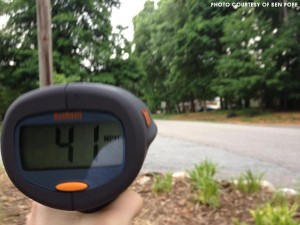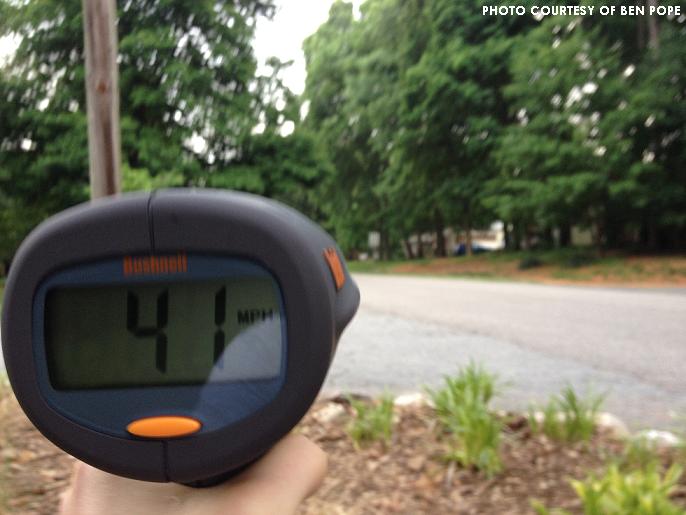
A popular shortcut route to the Leesville campus has become a haven for speeding.
The so-called “Springdale Loop” — a 1.4-mile section of O’Neal Rd. often used to escape the half-mile morning traffic jam on southbound Leesville Rd. — takes, according to Google Maps, four minutes to drive. But Leesville students are eager to reduce that estimate.
On a recent weekday morning, The Mycenaean conducted a speed study at the second O’Neal Rd. intersection with Lakewood Dr., a two-way cross street 0.8 miles around the loop. Between 6:47 and 7:17 A.M., the prime time for student traffic, 49 cars passed by in the direction of Leesville Road High.
The results were shocking.
By the Numbers

All 49 cars were travelling above the speed limit of 25 MPH. In fact, the speed limit seemed practically negligible in its psychological competition with avoiding first period tardiness. All but one car was travelling at or above 30 MPH, and 18 were moving at 40 MPH or faster.
The average speed was a stunning 37.7 MPH, more than 50 percent greater than the speed limit.
Speeds increased significantly as the 7:25 AM bell approached; the 17 cars which passed by after 7:07 averaged 40.1 MPH, as compared to the 36.5 MPH average speed of cars prior to that time.
The highest speed registered in at a whopping 47 MPH, but two others would also have been speeding even if in a 45 MPH zone.
Results also provided convincing evidence that the army of speeders can be directly tied to school traffic: one car passed by between 6:47 and 6:56, while 24 passed by in the following 10-minute span.
In addition to blatant and exorbitant ignorance of the law, such reckless speeds on a curvy, driveway-lined road endangered others nearby. More than a dozen cars passed by (two of which were traveling faster than 40 MPH) while an older lady was walking her dog alongside the road. A handful more sped past several morning joggers.
Springdale faces conundrum
John Rhoades, the Springdale community representative to the N.C. Department of Transportation (DOT), is concerned about the results. “It would be nice for the LHS drivers to be reminded of the severe consequences this speeding brings…(a) injuries, (b) higher insurance cost, (c) legal cost,” he wrote via email.
“The S.E.A. has communicated with LHS in the past, trying to ‘be a good neighbor’ and not ‘call the cops’ because we all realize what unpleasant cost that brings to Families. However – this needs to stop. Only with vigilant reminders to all LHS Parents of drivers from LHS throughout the year will we make a dent in this activity.”
Paul Nani, former Springdale Homeowners Association president, added more detail into the community’s prior efforts to reduce speeding. “We have tried to develop ways to curb speeding in our neighborhood however no plan (stop signs, speed bumps…) has been approved that would provide a substantial solution to this problem,” he wrote, also via email. Yet Rhoades notes that four-way stops have drawbacks of their own, as drivers are forced to brake and accelerate quickly and create unnecessary noise.
The community is truly stuck in a no-win situation with school-related traffic issues.
Widening Leesville Rd. south of Fairbanks Dr. may reduce traffic and thus eliminate the incentive to use the Springdale Loop, but such large-scale construction requires loss of land as well as noise and aesthetic inconveniences.
The community has also faced some criticism for not building a sidewalk alongside Leesville, which would allow for a safer crosswalk at the O’Neal Rd. stoplight.
However, since Springdale — as noted by Rhoades — is considered a Wake County-regulated area, state DOT support is scarce and the same traffic controversies that existed a decade ago exist just the same today.
Safety concerns significant
Regardless of the long-term reaction and solution to the issue, it’s eminently clear that speeding through the Springdale loop is a serious concern.
According to the organization KKAD25, each 5 MPH increase in speed in 25 MPH zones leads to a five percent increase in incapacitating pedestrian injuries. Moreover, “crash rates increase faster with an increase in speed on minor roads (which includes residential streets) than major roads.”
Perhaps even more perplexing is that such speeding actually accomplishes little to nothing in the Springdale situation.
Since the entire loop is a no-passing zone (and we noted zero instances of passing in our study) and no other efficient “shortcut” roads intersect with it, it is highly likely that drivers will find themselves in the same place in line of traffic no matter how slowly they drive around.

Leave a Reply